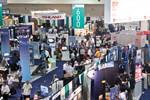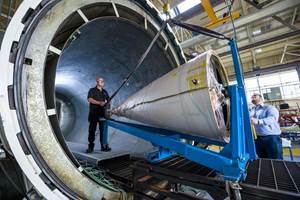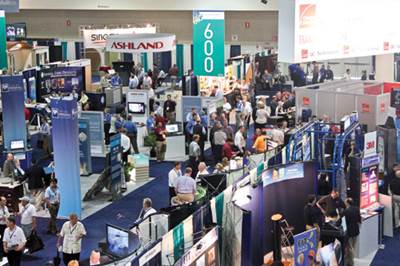Retired U.S. Army general Stanley McChrystal, who until mid-2010 was the commander of the international armed force in Afghanistan, spoke to a standing-room-only crowd at COMPOSITES 2011. His keynote comments centered on leadership and change management.
McChrystal, who now teaches at Yale University, led off with a thank-you to the composites industry, noting the critical protective role composites-based vehicle and personnel armor plays in helping keep American soldiers safe in the Iraq and Afghanistan conflicts. He then shifted to the focus of his speech, which he called “plywood leadership” — the belief that good leadership helps build human systems that are, like plywood (or, for that matter, composites), greater than the sum of their parts. Such leadership, he noted, was lacking in the lead-up to the 9/11 terrorist attacks (“We had the intel to stop the attacks”) and the 2008 financial crisis that triggered the current economic meltdown.
“We’re desperate for leaders in America,” he noted, emphasizing a three-prong leadership strategy that encompasses a keen focus on problems, a willingness to embrace change and the ability to build trust. More concretely, McChrystal believes that good leaders must first identify and actually solve complex problems, implement change and understand how leadership affects other humans.
He illustrated many of his points via anecdotes about his service in the Middle East and, in particular, in Afghanistan, using the histories and cultures of this region to highlight different perspectives on the chronic misunderstandings between the citizens in those regions and American citizens. He noted, for example, that many Afghans believe that they, during their long war with the Soviet Union in the 1980s, effectively fought the Cold War for the West. The Afghanistan that survived the conflict, after millions of its people died and its infrastructure was devastated, has endured more years of internal conflict, massive instability and a complete lack of confidence — all of which, says McChrystal, gives Afghans a predominantly negative view of the U.S. Conversely, he said, America, which funded the war against the Soviet Union, believes it did Afghans a favor. “I argue,” he said, “that you can fly countries into the ground when you lose perspective.”
Although the ability to view problems from more than one perspective is critical and might lead to a change in behavior or problem solving, McChrystal believes the ultimate arbiter of change is the lack of status quo effectiveness. To highlight this, he noted the American tendency at the start of the Iraq conflict to impose on terrorists an organizational structure that mirrors those commonly found the West: a single leader, with several subordinates who have subordinates beneath them, and so on.
What he found in terrorist organizations, however, was a loose network of associations in which neither leadership nor decision making is centralized. Deciding that “it takes a network to defeat a network,” McChrystal reorganized his own command structure to mirror that of the terrorists. In centralized decision making, he said, senior people with access to inadequate information try (and often fail) to make decisions, but he believes that information must be pushed out into the network to the field of action and that soldiers should be empowered to make the decisions.
In their management of people, McChrystal believes strongly that leaders must develop and cultivate relationships. In Afghanistan, he made heavy use of videoconferencing to bring together people in multiple regions for daily field reports. To build trust and engage “teammates,” McChrystal said he made liberal use of one basic question — “What do you think?” — which he believes demonstrates a leader’s ability to listen and see other perspectives. “Relationships require work — honest, earnest, genuine effort,” he said. “Relationships give durability to an organization.”
Related Content
Parker Hannifin completes acquisition of Meggitt PLC
With the acquisition, Parker Aerospace Group aims to expand its portfolio with Meggitt’s global defense and aerospace technologies.
Read MorePlant tour: National Institute for Aviation Research, Wichita, Kan., U.S.
NIAR, located at Wichita State University in the heart of the American aerospace manufacturing industry, has evolved to become a premier hub of teaching, R&D, creativity and innovation.
Read MoreLarge-format 3D printing enables toolless, rapid production for AUVs
Dive Technologies started by 3D printing prototypes of its composite autonomous underwater vehicles, but AM became the solution for customizable, toolless production.
Read MoreMaterials & Processes: Fibers for composites
The structural properties of composite materials are derived primarily from the fiber reinforcement. Fiber types, their manufacture, their uses and the end-market applications in which they find most use are described.
Read MoreRead Next
COMPOSITES 2011 Product Showcase
Composite Technology magazine's review of the goings-on at COMPOSITES 2011, this year’s edition of the American Composites Manufacturers Assn.’s (ACMA, Arlington, Va.) annual trade show and conference (Feb. 2-4, Greater Ft. Lauderdale Convention Center, Fla.).
Read MoreComposites end markets: Energy (2024)
Composites are used widely in oil/gas, wind and other renewable energy applications. Despite market challenges, growth potential and innovation for composites continue.
Read MoreCW’s 2024 Top Shops survey offers new approach to benchmarking
Respondents that complete the survey by April 30, 2024, have the chance to be recognized as an honoree.
Read More














.jpg;maxWidth=300;quality=90)











